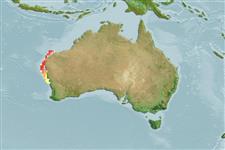>
Perciformes/Scorpaenoidei (Scorpionfishes) >
Neosebastidae (Gurnard scorpionfishes)
Etymology: Neosebastes: Greek, neos = new + Greek, sebastes = august, venerable (Ref. 45335); occidentalis: Name from the Latin 'occidentalis' meaning west, referring to the distribution of the species being the westernmost in the genus.
Environment: milieu / Zona climática / intervalo de profundidade / distribution range
Ecologia
marinhas demersal; intervalo de profundidade 100 - 185 m (Ref. 54394). Tropical; 20°S - 30°S (Ref. 54394)
Eastern Indian Ocean: Off the central western coast of Western Australia.
Tamanho / Peso / Idade
Maturidade: Lm ? range ? - ? cm
Max length : 18.0 cm SL macho/indeterminado; (Ref. 54394)
Descrição suscinta
Chaves de identificação | Morfologia | Morfometria
Espinhos dorsais (total) : 8; Raios dorsais (total) : 8; Espinhos anais: 3; Raios anais : 5. Diagnosis: Underside of mandible with numerous tiny pores, no ridges. Preocular spine usually divided into 2 points, and flattened anteriorly and posteriorly. There are no additional spines between lacrimal and suborbital ridges; upper opercular spine usually divided into 2-4 points; midinterorbital space extremely deep, usually not covered with scales; interorbital ridge distinct. Pored lateral-line scales 32-36 (mode 33); longitudinal scale rows 50-56 (55). Pectoral-fin rays 18-21 (21); pectoral fin long (2.4-3.0, mean 2.7 in SL), reaching or extending beyond a vertical at origin of last dorsal-fin spine. First anal-fin spine 1.5-1.7 (1.6) in third spine. Posterior margin of maxilla not reaching a vertical at posterior margin of pupil. Interorbital width wide (5.7-7.5, 6.8 in HL). Bilobed portion of swimbladder less than half of total swimbladder length; head and body whitish in preservative specimens. Body, head, and pelvic and anal fins nearly white or yellowish when fresh; no distinct small black spots on head or lateral line (Ref. 54394).
Body shape (shape guide): short and / or deep.
Found on the continental shelf (Ref. 75154). Most specimens taken in trawls have sand grains inside the mouth indicating occurrence on open, predominantly sandy substrata (Ref. 54394).
Ciclo de vida ou comportamento de acasalamento
Maturidade | Reprodução | Desova | Ovos | Fecundidade | Larvas
Motomura, H., 2003. Revision of the scorpionfish genus Neosebastes (Scorpaeniformes: Neosebastidae), with descriptions of five new species. Indo-Pac. Fish. (37):46 p. (Ref. 54394)
Status na Lista Vermelha da UICN (Ref. 130435: Version 2025-1)
Ameaça para os humanos
Harmless
Uso pelos humanos
Ferramentas
Relatórios especiais
Baixar XML
Fontes da internet
Estimates based on models
Preferred temperature (Ref.
123201): 19.2 - 22.7, mean 20.1 °C (based on 7 cells).
Índice de diversidade filogenética (Ref.
82804): PD
50 = 0.5002 [Uniqueness, from 0.5 = low to 2.0 = high].
Bayesian length-weight: a=0.01995 (0.00906 - 0.04395), b=3.01 (2.83 - 3.19), in cm total length, based on all LWR estimates for this body shape (Ref.
93245).
Nível Trófico (Ref.
69278): 3.6 ±0.4 se; based on size and trophs of closest relatives
Fishing Vulnerability (Ref.
59153): Low vulnerability (12 of 100).
🛈
